"Mysteries" of the Kulikov Field are completely solvable
21 September Russia celebrates the Day of Military Glory - the anniversary of the Battle of Kulikovo, which largely determined the fate of the country. In the Battle of Kulikovo Field, held on the feast day of the Nativity of the Most Holy Theotokos, the united army of the Russian lands, under the leadership of Prince Dmitry Ivanovich, defeated the mixed army of the ruler of the Golden Horde Mamaia.
But, although, according to the apt remark of the historian V. Shavyrin, “books devoted to the Kulikovo battle can be used to lay out the entire field where it happened”, there are still many real mysteries around this historical event.
The easiest way to explain why, if historians claim the battle was 8 September 1380, 21 September is the Day of Military Glory. Recall that in 1380, throughout the Christian world, the chronology was based on the Julian calendar. It is on this calendar that the Nativity of the Blessed Virgin Mary falls on September 8. In 1582, Pope Gregory III introduced a new calendar (called the Gregorian calendar), a leading Julian by 10 days. And with each new century, the gap widened for one more day. And to our time, the Gregorian calendar is ahead of Julian by 13 days.
Russia, however, up to the year 1918 adhered to the former, Julian calendar. Therefore, most of her dates stories period 1582 – 1918 usually translated into "new style" by adding the appropriate number of days. Dates before 1582 are usually not subject to such a transfer.
But it was for the day of the Kulikovo battle that it was decided to make an exception. The fact is that the Russian Orthodox Church still adheres to the Julian calendar, according to which the feast of the Nativity of the Most Holy Theotokos falls on September 8. According to the Gregorian calendar, on which our country now lives, this day falls on September 21.
However, it was precisely because this battle took place on the day of one of the greatest holidays of Orthodoxy, and this circumstance undoubtedly inspired the courage and valor of the Russian soldiers, and it was decided to establish the holiday date falling on the Orthodox feast of the Nativity of the Most Holy Mother of God. That is, on September 8 in the old style (aka - September 21 in the new).
The following question is much more complicated: so where is the Kulikovo field on which this great battle took place? According to the official version, established in the first half of the XIX century, it is located in the south of the Tula region, at the junction of Kimovsk and Kurkinsk districts. However, this version has long been subjected to very thorough criticism of modern scientists.
The history of its origin tells the military historian Alexander Shirokorad:
“There was a nobleman S.D. Nechaev - the director of the schools of the Tula province, the Tula landowner, a freemason, a Decembrist, a member of the Union of Welfare, a close friend of KF Ryleeva and A.A. Bestuzhev. In June 1820, the governor of Tula V.V. Vasiliev raised the question of the construction of a monument, "which marks the place where Russia was liberated and glorified in the 1380 year."
Needless to say, the place of the battle was found in the land of a rich landowner, SD Nechaev. In 1821, in the journal “Vestnik Evropy” (part 118, No. 14, p. 125-129) Nechaev wrote: “According to historical traditions, the Kulikovo Field was between the rivers Nepryadvoyu, Don and Mechei. Its northern part, adjacent to the confluence of the first two, still retains its ancient name between the inhabitants. ” Further, Nechaev points to the toponyms preserved "in this land" - the village of Kulikovka, the village of Kulikovo, the Kulikovsky ravine, etc. In these places, according to Nechaev, "they plow out the most ancient weapons, bells, swords, spears, arrows, also copper and silver crosses and fold. Before the tiller of the farmer, he also tore off human bones. ” But the author considered “the strongest evidence” (we will note this!) Of his opinion to be “the position of the Green Oak Forest, where an ambush was hidden, which“ decided the bloody Kulikovo battle ”. According to Nechaev, the remnants of the oak trees and now exist in the cottages of the village of Rozhdestven, or Monastyrschiny, "lying on the very mouth of the Nepryadva."
In the book “Mysteries of Ancient Russia” published at the beginning of XNUM-s, the “non-Chaevist” version - and the “official” that has been based on it since then - has been subjected to a scathing revision. The authors of the book, for example, pointed out the following: “The strongest evidence” of Nechaev about the location of “Green Oak Wood” does not stand up to criticism at all. Where did Nechaev take that Green Oakwood is a proper name? Yes, in the monuments of the Kulikovo cycle the “oak grove” or “green oak grove” is mentioned, hiding the ambush regiment of prince Vladimir Serpukhov. So what? In Russia in summer, all the oak trees are green. Where does it come from that the Green Oakwood is a proper name?
The objects found by Nechayev on the Kulikovo Field (where exactly? In what place?) And published by him in the “Vestnik Evropy” in 1821 year, were repeatedly reproduced and continue to be reproduced in various publications devoted to the Kulikovo battle. However, we have never found any comments interpreting these findings (except for the comments of Nechaev himself, who all dates back to the time of the Kulikovo battle).
We turned for help to a well-known archeologist, corresponding member of the Russian Academy of Natural Sciences, Doctor of Historical Sciences AK Stanyukovich with a request to comment on the findings of Nechaev. Here is his interpretation of the finds.
Streletsky berdysh (second half of the XVI – XVII centuries), the tip of the Tatar-Mongolian arrow (“cut”) (XII – XIV centuries), the cross of the body (middle of the XVII century), the cross of the body (XIV – XVI of centuries), the cross body (“degenerate encolpion”) (XV century), cross-enkolpion casement (end of XII - first half of XIII centuries, southern Russia (Kiev?)), icon-enkolpy (XIV century, Novgorod); chest obrazok with the image of St. Fedor Stratelates (XII century.).
As you can see, only 2 from 8 items can be considered a stretch of the time of the Kulikovo battle ...
As for Nechaev’s assertions about some massive discoveries of “ancient weapons” at the place of the Kulikov battle, which he had chosen, no one, even Nechaev, saw these finds, so leave this statement without comment. ”
(AB Shirokorad "The Battle of Kulikovo and the birth of Moscow Rus").
But long before the publication of Shirokorad’s book, and the Mysteries of Russian History, Academician Anatoly Fomenko and his co-author Gleb Nosovsky back in 1993 subjected the “non-Chaevist” official version to the same, if not more valid criticism.
“Having plowed about 25 hectares of land, archaeologists found only something:
- Several arrowheads, which are not necessarily left from the battle and could belong to ordinary hunters.
- One iron ring - perhaps from the chain mail, and maybe not.
“Another one or two small pieces of iron, supposedly parts of heavy armor.” And maybe, at all and not an armor, but plows, for example.
Here, in fact, and all, Similar finds, armed with a good metal detector and having searched the area in 25 ha, can be found almost anywhere in Mother Russia. To do this, it is not necessary to go under Tula, ”- this is how they commented on the results of the archaeological research conducted from the beginning of the 1980-s of the Upper-Don archaeological expedition of the State Historical Museum.
In their recently published work “Where are you, Kulikovo field?” Anatoly and Tatiana Fomenko and Gleb Nosovsky note that the archaeologists themselves who conducted these excavations were fairly discouraged by their results. In the television movie “Ghosts of Kulikovo Field”, which was released on the First Channel 1 in November 2002 (written by Ieva Pozharskaya, directed by Igor Ushakov, hosted by the historian Sergey Ilyin-Kozlovsky and Doctor of Historical Sciences Valery Ivanov-Tagansky on issues of the Kulikov battle, the head of the Center for the History of Ancient Russia of the Institute of Russian History of the Russian Academy of Sciences, V. A. Kuchkin, and the head of the Upper-Don archaeological expedition of the State Historical Museum on the Kulikovo Field, M. I. Gonyaniy It was noted that “from 26,5 ga Kulikova field passed 25. This full-scale operation of archeologists on the clearing of the Kulikovo field was expressed in four arrowheads, several reliquaries and a fragment of heavy armor. ”
Therefore, archaeologists were even ready to start looking for another place for the Kulikovo battle, but, as noted by Fomenko and Nosovsky, then they probably decided that “transferring the place of the Kulikovo battle is far from harmless to the generally accepted version of Russian history. What if it turns out that the battle was in Moscow, as we say? Then today's familiar picture of Russian history crumbles like a house of cards. If in the XIV century. in place of Moscow there was a clean field where Dmitry Donskoy fought with Mamai, then where was the Russian capital at that time? And why do not the annals say anything about her other location? And is it possible to trust such annals if they even indicate the wrong place of the capital? In fact, all major sources in Russian history are immediately suspicious of late forgery. If you pull this dangerous thread, then the false building of Russian history, created in the eighteenth century. visiting professors-historians from Germany, and still carefully serviced by domestic historians, will not be able to resist. ”
At the same time, Fomenko and Nosovsky themselves do not at all deny the fact of the Kulikovo battle (as, by the way, some Russophobic history revisionists have already begun to do). On the contrary, they believe that "the Kulikovo battle was truly the greatest battle that changed the course of world events and has a huge number of different reflections scattered across the pages of historical textbooks." They offer more detailed information on this issue in their previously published works on new chronology, in particular, “Baptism of Russia”, “Tsar's Rome between the Oka and Volga rivers”, “The Conquest of America by Yermak-Cortes and the Rebellion of the Reformation through the eyes of the“ ancient ”Greeks” .
However, in the book “Where are you, Kulikovo Field?”, They first of all argue in favor of their version that the real Kulikovo battle took place precisely between the modern Moscow River and Yauza, and list its traces in toponymic, cultural and archaeological sources. “There are so many traces of them that in a small book we can’t even cover them all. Therefore, we will tell only about the most vivid traces of the Kulikovo battle in Moscow. For a more detailed exposition, we refer the reader to our books, New Chronology of Rus, Moscow in the Light of New Chronology, and also to the full-color edition Rus. A true story, ”the authors indicate in the preface to their work.
They insist that if one does not adhere blindly to the chronology of Scaliger-Petavius, which has been imposed on mankind in the mass consciousness, the notorious “riddles” of the Kulikov Field are completely solvable.
“In the new chronology there is no prohibition on the fact that in the XIV century. in place of the city of Moscow there was a major battle. For historians (standing on the basis of the mentioned chronology of Scaliger-Petavius. - Approx. KM.RU) there is such a ban. Namely, they believe that the city of Moscow was founded by Prince Yury Dolgoruky back in the twelfth century. n e., and at the beginning of the XIV century. Moscow was already the capital of Russia. It is clear that there could be no major battle on the streets of a big city. They fought always in the open field.
According to the new chronology, the generally accepted dates of the foundation and elevation of the city of Moscow are erroneous. As our research has shown, the present city of Moscow probably arose only at the end of the 14th century, in the epoch of the Kulikovo battle, and then only as a small settlement. This settlement to the XVI century. Moscow was not called. The river on which the city of Moscow stands today is also not called the Moscow River.
Until the sixteenth century, the city on the site of Moscow, apparently, was called Krutitsa. The trace of this old name is the Krutitsky Metropolitan Compound in Moscow. According to our reconstruction, Vladimir-Suzdal Russia was called Moscow until the middle of the XVI century. The capital cities of Vladimir-Suzdal Russia - Yaroslavl, Rostov, Vladimir, Suzdal, Kostroma could also be called by this name. (See the details in our books "New Chronology of Rus", "Russia and the Horde", "Russia and Rome", "Moscow in the Light of the New Chronology".)
Therefore, according to the new chronology, it is not surprising that at the end of the XIV century, when there was still a clean field and virgin forests in place of Moscow, the greatest battle of Russian and world history took place here. Maybe it was thanks to the Kulikov battle that the Russian capital, the city of Moscow, was subsequently formed here, ”Fomenko and Nosovsky explained their theory.
They also point out: “Our thought is indirectly confirmed in the next old Moscow tradition. The famous historian of Moscow I.E. Zabelin wrote that when at the beginning of the sixteenth century. they began to say that Moscow is the Third Rome, “there was a need to prove that the Third Rome is Moscow and in its beginning does not move away from its two fellows (i.e. the first two Romes. - Auth.), exactly BASED ON THE BLOOD PROLIGATION. ” The opinion of our ancestors that Moscow stands on blood was not a political invention. It was true. The city of Moscow, as we now understand, has arisen on the site of the cruelest Kulikovo battle. That is, in the full sense, on the blood ... But there were too many remains. A part still lies in Moscow land - on Kulishki, in the old Moscow monasteries of Staro-Simonov and Andronikov. There are huge mass graves of the fallen on the field Kulikovo. ”
In support of his hypothesis, Fomenko and Nosovsky recall that some chronicles directly indicate that KULIKOVO FIELD WAS IN MOSCOW. For example, the well-known chronicler of Arkhangelsk, describing the meeting of the icon of the Vladimir Mother of God in Moscow during Timur's invasion, says: August, on 26 day. ”
The mentioned church stands, as is known, on Sretenka. And not far from Sretenka in Moscow there is a place, still known under its ancient name "KULISHKI".
The opinion that the Moscow toponym "Kulishki" is closely connected with the Kulikovo field existed in Moscow at least until the 19th century. For example, the collection “Old Moscow”, published by the Commission for the Study of Old Moscow under the Imperial Moscow Archeological Society, mentions the alleged “wrong assumption” that existed in Moscow that Moscow’s “Kulishki originated from Kulikov or Kulikov Field”. It also noted that "Kulishki existed before Moscow."
It is on Kulishki that the Church of All Saints stands, which, “according to the old legend, was built by Dmitry Donskoy in memory of soldiers killed on the Kulikovo Field”.
Moscow Kulishki also captured the area of the Pokrovsky Gate, which had 3 – 4 centuries ago and the second name - Kulishsky. “According to our research, it was in this place of Moscow that the famous battle of Kulikovo took place,” claim Fomenko and Nosovsky.
At the same time, they provide a voluminous list of toponymy - the names of the Gatei, fords, hills and localities, which are known from the chronicles and tales of the Kulikovo battle, and correspond precisely to Moscow Kulishki. Red Hill, Kuzmina Gat, the Chur River on Mikhailov, etc., which are not on the Tula Kulikovo Field, Fomenko and Nosovsky easily point on the map of modern Moscow. As well as the Silent and Rapid Pines - the river, where, according to the chronicles, were Russian patrols. Such rivers really exist - but in the Belgorod region, more than 150 versts from “Kulikovo Pole”. In Moscow, Fomenko and Nosovsky point to the Sosnovka River, which flows north and south of Kulishek.
There are no similar toponymic coincidences on the Tula Kulikovo field. Yes, in fact, they can not be, because even according to official data, permanent settlements in those regions appeared only at the end of the XVI - beginning of the XVII centuries.
Even the names of rivers (as is well known, these toponyms are usually the most ancient and store elements of the languages of long-disappeared peoples) are also clearly not in favor of the official version. The name of the Don River itself, noted Fomenko and Nosovsky, does not necessarily have to be associated exclusively with the modern Don. For example, M. Fasmer's Etymological Dictionary of the Russian Language reports that for many centuries the words “Don” and “Danube” in Indo-European languages meant a river in general.
E.P. Savelyev writes: “The names of the rivers and in general the waters“ don ”,“ tone ”,“ dan ”,“ tun ”,“ dun ”are very ancient, found on the threshold of the history of Aryan peoples throughout Europe and Western Asia and have been kept until now in one language, the Ossetians ... The mouths of the rivers bore the common name “Donye”, “Tonya” or “Tone”, which so far have been held in many places of the Slavic lands, like, for example, among us and the Serbs.
“Saveliev is absolutely right that in“ antiquity ”the word“ don ”meant any river. But, following the incorrect chronology of Scaliger, he believes that “antiquity” had already ended several thousand years ago, long before the Battle of Kulikovo. This is not true, ”clarify Fomenko and Nosovsky.
“By the way, the modern river Don was called“ The Quiet Don ”, i.e.“ The River Tikhaya ”. Moreover, “Zadonshchina” in some places quite clearly means the Moscow River when it talks about the Don River. For example, the princess, “Marya, early in the morning, was crying on the visors of the Moscow walls, lamenting:“ O Don, fast river ... bring on my waves my Mr. Mikula Vasilyevich to me. ” But if the princess’s request to bring the body of the deceased prince straight to the MOSCOW WALLS - on which she stands - is facing the Don River, then it means DON STROKE THROUGH MOSCOW. What river flows through Moscow? That's right, the Moscow River. Thus, our idea that the Moscow River is named Don here receives direct confirmation of the original source, ”concluded Fomenko and Nosovsky.
The same thing with Nepravdva. In the Geographical Description of the Russian Empire, published by Moscow University in 1776, its author, Khariton Chebotarev, lists in detail all the rivers that flow into the Don, but Naryadvaya is not among them. And suddenly, after half a century, it turns out that she "is": it turns out that she flows through the possessions of landowner Nechaev! It is quite reasonable to assume that if this landowner added even a flintlock and cannonballs to the "finds" on the site of the Kulikovo battle, then it would cost him nothing to say implicitly to the little river in his estate.
Meanwhile, Fomenko and Nosovsky prove in detail that the real river, today called Yauza, fully corresponds to the chronicle Nepryadva. And in the interfluve of the Moskva River and the Yauza just Kulishki are located.
“Let us reveal, for example, the Facial Chronicle - an extensive, richly illustrated chronicle belonging to the seventeenth and eighteenth centuries. Russian kings. It clearly shows there that Dmitry Donskoy fought with Mamai in the mouth of the Nepryadva, right on the arrow of two rivers. Can we indicate the river Nepryadvu in Moscow? Yes we can.
From the comparisons of the Kulikov and Moscow names we have already made above, it follows that Nepryadva, which, according to the chronicles, flowed right across the battlefield, should correspond to the Moscow river Yauza. In this case, there is simply an ideal correspondence between the chronicle geography of the Kulikovo battle and the true geography of Moscow Kulisek. There is nothing of the kind on the Nechayevsky Kulikovo Field, ”emphasize Fomenko and Nosovsky.
“The slopes of the hills surrounding the Yauza-Nepryadva estuary from all sides, when approaching the mouth, become very sloping and gradually turn into a vast field between Yauza and the Moskva River. This is Moscow Kulishki. BUT IT IS AS DESCRIBED AND KULIKOVO FIELD IN THE FACIAL SECRETARIUM RECORD: “... and stash on the Kulikovo field, on the mouth of the Nepryadva-river. But this field is great and pure, and the debasement is great in the hands of the Constant. ” Let's pay attention to one more interesting detail.
The Chronicle reports that Mamai's troops descending from a high hill on Kulikovo Field were VERY CLOSELY at the entrance to the battlefield. So crowded that for some time they were even forced to stand still, since "they had no place to part." How can this be explained? On the Nechayevsky “Kulikovo Field” - ANYTHING.
There are neither hills, nor sufficiently deep rivers, nor any other obstacles at the entrance to the battlefield. But if Nepryadva is Yauza, then it could not be otherwise. Just look at Kulishki. The troops of Mamaia simply could not help but be shy in the small space between Yauza and the foot of the Red (Tagansky) hill, before all the soldiers could cross the bridges over Yauza to Kulishki - Kulikovo Field. And again we see the perfect correspondence between the chronicle description of the Kulikovo field at the mouth of the Nepryadva and the Moscow Kulishki at the mouth of the Yauza - cooperation that goes to the smallest details. ”
A.Fomenko and G.Nosovskiy according to the results of their research come to the conclusion that the soldiers who fell in the Kulikovo battle were buried on Kulishki, in the Staro-Simonov and Andronikov monasteries, where there are indeed traces of mass graves. Meanwhile, in the area of the "Nechaevsky" Kulikov field of the traces of burial tens of thousands of dead were not found. Moreover, as noted by Fomenko and Nosovsky, even if the Russians took the remains of their warriors to bury in their native land (although there were no such customs, and therefore this is unlikely), then where did the bodies of thousands of dead Horde go?
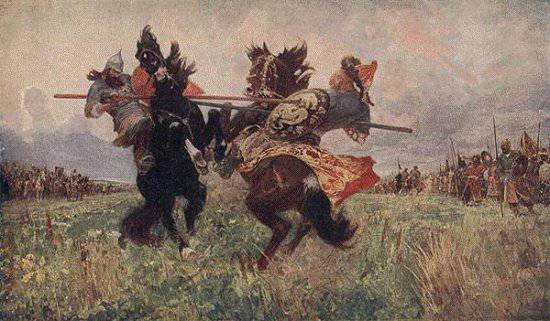
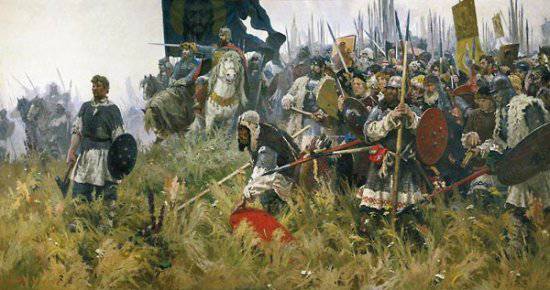
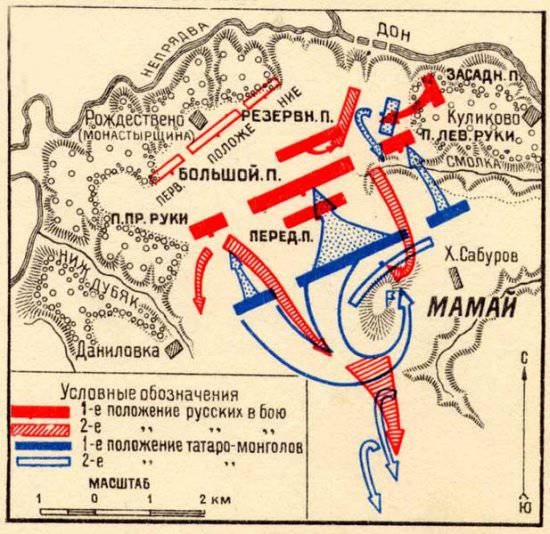
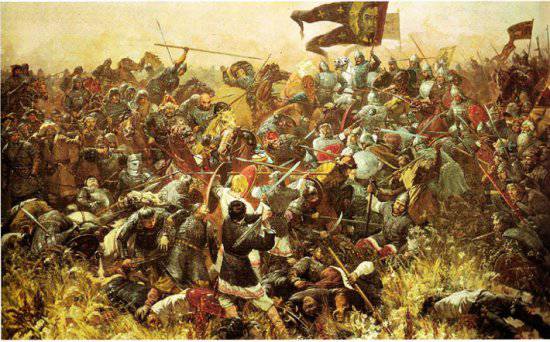
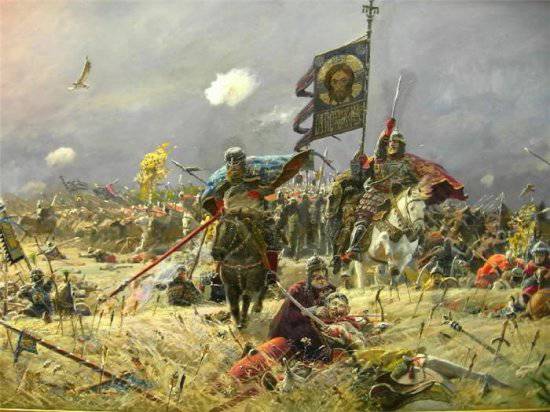
Information